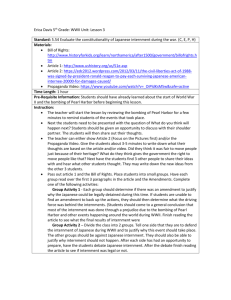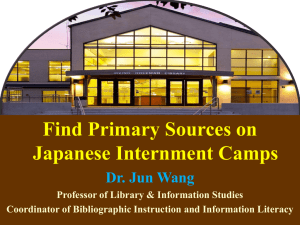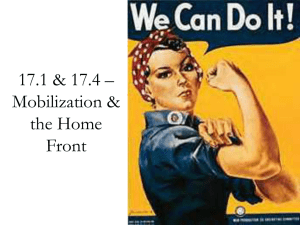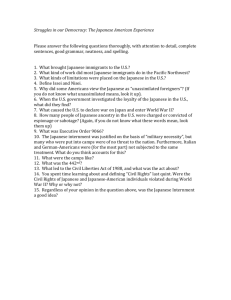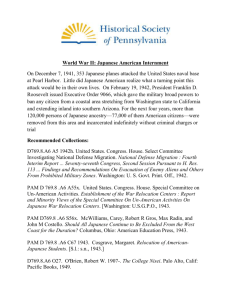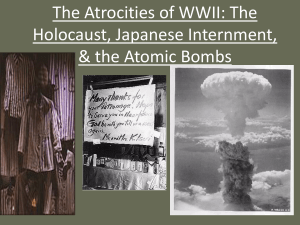WWII Homework 2: Prejudice at Home
advertisement
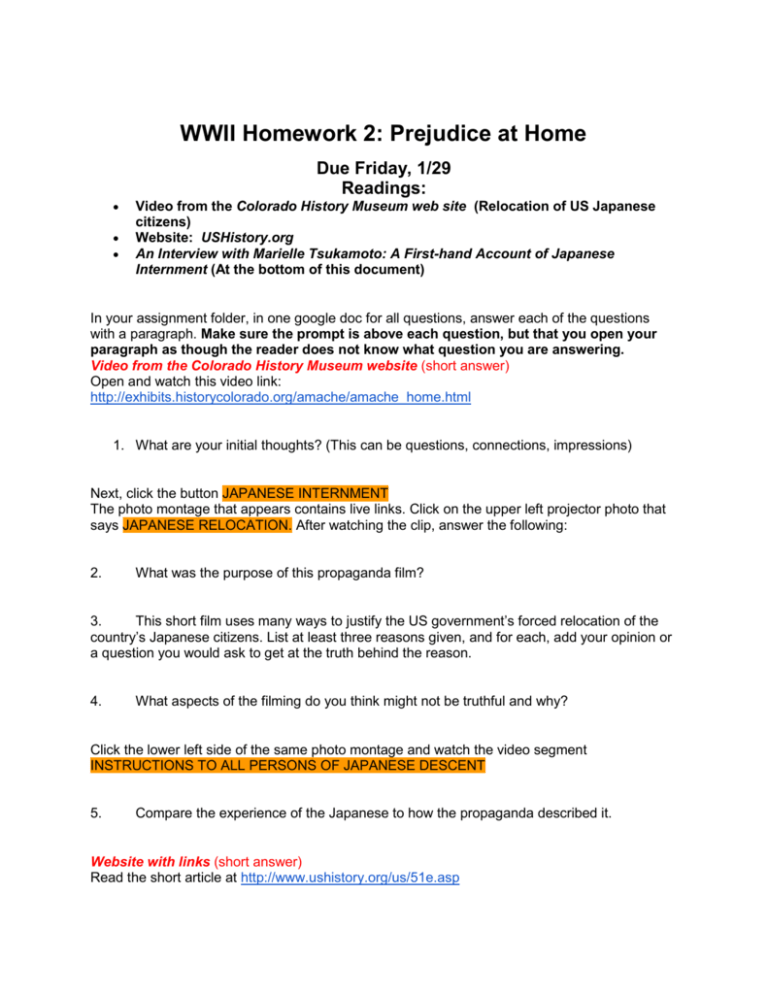
WWII Homework 2: Prejudice at Home Due Friday, 1/29 Readings: Video from the Colorado History Museum web site (Relocation of US Japanese citizens) Website: USHistory.org An Interview with Marielle Tsukamoto: A First-hand Account of Japanese Internment (At the bottom of this document) In your assignment folder, in one google doc for all questions, answer each of the questions with a paragraph. Make sure the prompt is above each question, but that you open your paragraph as though the reader does not know what question you are answering. Video from the Colorado History Museum website (short answer) Open and watch this video link: http://exhibits.historycolorado.org/amache/amache_home.html 1. What are your initial thoughts? (This can be questions, connections, impressions) Next, click the button JAPANESE INTERNMENT The photo montage that appears contains live links. Click on the upper left projector photo that says JAPANESE RELOCATION. After watching the clip, answer the following: 2. What was the purpose of this propaganda film? 3. This short film uses many ways to justify the US government’s forced relocation of the country’s Japanese citizens. List at least three reasons given, and for each, add your opinion or a question you would ask to get at the truth behind the reason. 4. What aspects of the filming do you think might not be truthful and why? Click the lower left side of the same photo montage and watch the video segment INSTRUCTIONS TO ALL PERSONS OF JAPANESE DESCENT 5. Compare the experience of the Japanese to how the propaganda described it. Website with links (short answer) Read the short article at http://www.ushistory.org/us/51e.asp 6. What was the name of the internment (or concentration) camp in Colorado? Read the short article, then go to the tab on the left entitled Evacuating Japanese-Americans Skim the article, then click the link 1942 San Francisco War Events timeline Find the entry for February 2, 1942. 7. What can you infer is happening in the homes of Japanese Americans? 8. What do you make of the suggestion of how the Japanese workers can be replaced? 9. Read the first-person account below and make at least three annotations about things that you would need to research further to fully understand what she refers to. An Interview with Marielle Tsukamoto: A First-hand Account of Japanese Internment How long did your family spend in an internment camp? We were sent from Florin, California, to a temporary facility at the Fresno County fairgrounds for 6 months beginning in May of 1942. From there our family along with others from California were sent to Jerome, Arkansas. We were never at Topaz. The US government set up 10 internment camps in various locations in the United States. These camps were located in desolate, unpopulated places throughout the continental states. The government did not want the people of the United States to know much about the internment of 120,000 Americans of Japanese ancestry. What is one thing you would like everyone to know about Japanese American internment.? First, I would want everyone to know that all of us, the American citizens born in this country as well as our grandparents and parents who originally came from Japan were innocent of any wrong. We were loyal Americans. The FBI and military investigated all persons of Japanese ancestry and found we were loyal Americans. There was no single incident of any hint of treason or wrong. What was a typical day like for you in the camps? A typical day in an internment camp such as Jerome would begin with families getting up. Remember we did not have any water in our rooms. We just had one light bulb and a small stove. We had to get dressed and go to the middle of the block to use the toilet, wash up and take showers. Usually there were people waiting in lines. After you brushed your teeth and cleaned up, you had to go to a separate building for breakfast, lunch, and dinner. They had two sessions. If you were late or forgot your ticket, you could not eat. We stood in line for the food, which was served on metal trays, and we sat at long wooden tables with benches. There really wasn't much to do the rest of the time. My dad ran the recreation center for our block. Mother organized and coordinated YWCA (Young Women's Christian Association) and USO activities. The USO was organized to welcome Nisei soldiers who were visiting their families. At night we would stay in our room. We didn't have TV in those days. And we did not have a radio. What do you remember about having to leave your home in Florin, California? We lived on a small farm in Florin, California. My father raised grapes and strawberries. I had a small Australian shepherd named Uppie. I remember going into our garden and seeing my grandmother crying on the day we left. I told her not to worry; she would come back and her beautiful garden would still be there. Family friends drove us to the railway station in Elk Grove. I was not allowed to take my dog. He died before we returned. My dads' good friend, Bob Fletcher, took care of our farm, so we had a farm to return to. This was not true for most of the other families that lived near us. What were the saddest memories you remember? I think the saddest memory is the day we had to leave our farm. I know my mother and father were worried. They did not know what would happen to us. We had no idea where we would be sent. People were all crying and many families were upset. Some believed we would not be treated well, and maybe killed. There were many disturbing rumors. Everyone was easily upset and there were many arguments. It was a horrible experience for all of us, the old people like my grandparents, my parents and children like me. We were all innocent. The government had no real reason to send us into these camps. There were racists who did not want the Japanese to own land and begin to prosper. Racism, prejudice, greed, and lack of political leadership caused the evacuation and internment. What were some of the happy moments you remember? I remember getting some Christmas presents in Jerome. My grandmother made me a pair of mittens. Most of the presents we received were made from things people found in camp. My dad made a cute woodpecker to put by our door so I would know which room was our home. All of the barracks and doors looked alike. I was only four and could not read the letters and numbers on the buildings, so I would get lost sometimes after using the bathroom. What would you like us to know about your mother? I want people to know that she was a great teacher who loved her family and her country. She had the courage to speak out and do something about the injustice. She worked hard to pass redress. When a group of people feel they have been treated unfairly by the government, the US Constitution guarantees you the right to redress the government. The Japanese Americans did that and because the Civil Liberties Act of 1988 was passed by Congress, our constitution is strong again. It was weakened by Executive Order 9066 when President Roosevelt ordered 120,000 innocent Japanese Americans into internment camps. Mary Tsukamoto always took the initiative to follow her beliefs. She was a respected author (she wrote the book, We the People, a Story of Internment in America), a political activist and someone who worked for world peace. She was selected by the California State Senate as a Notable Californian.



